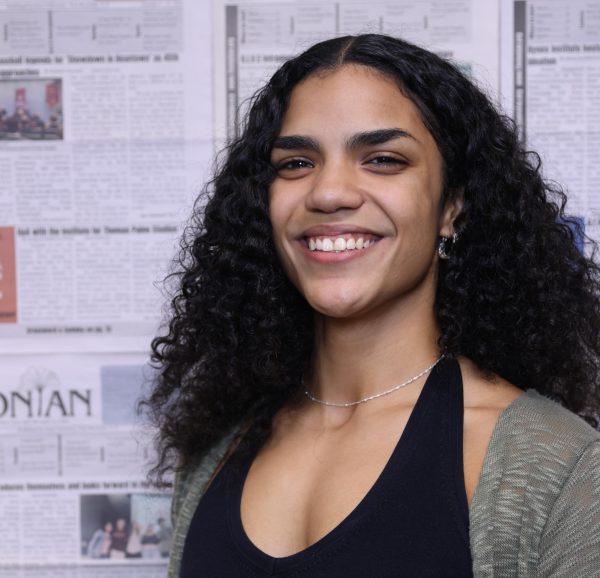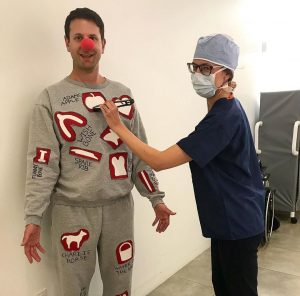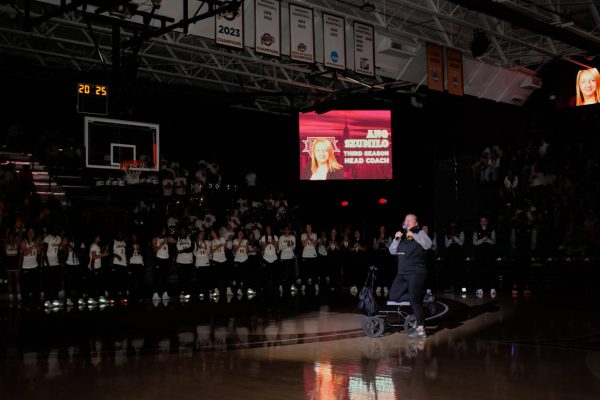Iona’s Dance Ensemble Review
April 20, 2023
There is a slight bend in the sidewalk tracing the left side of Iona University’s soccer field, and it is likely that more than 500 people walk it daily. Barely curving, this wide, crescent-shaped walkway is designed to connect the back of the campus to the front and let the two become one as approachable pass-byers wave or glance at one another in their conversion of destination.
How does one depict this bend, or let alone this artistic transaction of decency within a community, in body movements?
The answer to this question was one Iona’s 2023 spring dance ensemble was hoping to find in their dance concert “Art’s, Architecture and Community:” a production exploring the “arts and architecture that surround us and shape our communal environments,” dance ensemble director Dr. Hannah Park wrote in the program’s Director Notes.
While it does not seem easy to shape your body in ways that seem effortless or significant for the depictions of various life forces, both the students, faculty and production crew making up this semester’s dance ensemble demonstrated a profound interpretation of Iona’s arts, architecture and community. Joined on a stage by nothing other than the air that carried them and the stage lights that illuminated them, the dance ensemble took to Murphy auditorium’s stage to capture the structure of the architecture and communities that enable their movements.
The opening dance number, “Arts, Architecture, Community,” made use of a projector, which displayed the dance ensemble’s co-created dance film as each dancer individual pranced the stage with film-mirroring movements that rocked between sharp and gentle. The piece was inspired by Mitchell Rose’s “Exquisite Corps,” a dance film that captures people experimentally moving freely in the confines of communal environments. Choreographed by each dancer, the number allowed for the expression of individuality in a communal setting.
The use of technology, such as projected films and images, the lighting and engineered music, throughout the concert helped the ensemble’s depiction of architecture come to life. The second dance was preformed amongst the projected backdrop of the Luray Cavern in Virginia. The cave is decorated with an abundance of dripping speleothems and suggested the audience think of times in which humans were most capable of expressing their inner beast: the Paleolithic Era. The dancers, with movements that transformed from stillness and falling support into springing hops and symmetrical balance, kinetically described the idea of “the inner beast.”
Many of the dances in the production lacked synchroneity and infused the concept of community with varying movements all occurring the same iterations of music. In the show’s last performance titled “Kujega,” choreographed by Professor Andrea Markus, the dancers pounded the stage with diverging stomping movements that resembled the rhythmic and drumming music accompanying them. While some may say a stage lacking synchroneity entails confusion, the dancers’ contemporaneous movements, reminiscent of African diaspora, made for a communal and whole performance.
In dance, these ideas of community and art are not as hard to depict as architecture is. Drawing inspiration from the buildings and architectural designs that surround them, these students embraced the idea of Iona’s campus being a space designed for bonding as well as self-expression like many other college campuses. Many of the solo performances, including Park’s dance on screen performance “With the Wind,” used the entirety of the stage with growing movements—movements that once felt confined a single spot on stage soon exploded and scattered to different places, much like this idea of self-expression on college campuses. These solo performances felt effective in the program’s illustrations of architecture.
The ensemble also performed some jazz numbers that were entertaining to watch but felt a bit out of place with the program’s main objective: portraying arts and architecture that reflect community. The ensemble’s “Le Jazz Hot” performance, choreographed by Professor Lisa Harvie, was a nod to the past communities of 1930s Paris but did not connect with the other performances hinting at themes of “community.” The dance itself was a pleasant experience, yet very much the black sheep of program. The performance threw the show off its cohesion and lessened the show’s harmony.
What was an effort to represent architectural elements that exist within the human body—such as the heart, brain, nervous system, etc.—failed in the solo dance “Zing Went the Strings of My Heart” but succeeded in college senior Christele Romulus’ performance “Re-discovery of the Self.” Much like the group jazz number “Le Jazz Hot,” the jazz solo choreography felt lackluster. Often traveling back and forth between upstage and downstage. Romulus’ dance was modern and full of Afro-Caribbean aesthetics.
Considering what little time the ensemble had to choreograph, rehearse and put together various dances, the overall concert was strong and lively; it was able to achieve its goals of depicting themes of “explosion and implosion” as Park put it. Its strengths were within the African-inspired and contemporary dances but are lost in the jazz pieces, and this may be because themes like “arts, architecture and community” can be loose and lack specificity, broadening the concert’s dance repertories and lessening clarity.
Still, there is credit to give to the performers who searched within themselves to retrieve movements exploratory of the campus and people that inspire and surround them. In the concert’s final moments, there was this cathartic element of reliability, and the dancers catch, summon, lift each other and dance until the very last second of the drumming beat that inspired them.




